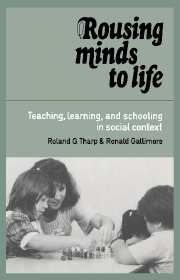Book contents
- Frontmatter
- Contents
- Acknowledgments
- Introduction
- Part I Teaching, schooling, and literacy: a unified theory of education
- Part II Practice
- 6 A school organized for teaching: the Kamehameha Elementary Education Program
- 7 The activity setting of the instructional conversation: developing word and discourse meaning
- 8 The orchestration of activity settings: learning and social interaction in the whole group and independent centers
- 9 The interpsychological plane of teacher training
- 10 Assisting teacher performance through the ZPD: a case study
- 11 The intrapsychological plane of teacher training: the internalization of higher-order teaching skills
- 12 The schools in mind and society
- References
- Author index
- Subject index
6 - A school organized for teaching: the Kamehameha Elementary Education Program
Published online by Cambridge University Press: 05 June 2012
- Frontmatter
- Contents
- Acknowledgments
- Introduction
- Part I Teaching, schooling, and literacy: a unified theory of education
- Part II Practice
- 6 A school organized for teaching: the Kamehameha Elementary Education Program
- 7 The activity setting of the instructional conversation: developing word and discourse meaning
- 8 The orchestration of activity settings: learning and social interaction in the whole group and independent centers
- 9 The interpsychological plane of teacher training
- 10 Assisting teacher performance through the ZPD: a case study
- 11 The intrapsychological plane of teacher training: the internalization of higher-order teaching skills
- 12 The schools in mind and society
- References
- Author index
- Subject index
Summary
The Kamehameha Elementary Education Program (KEEP) developed from a 15-year continuous research-and-development program for improving the cognitive and educational development of a group of educationally at-risk ethnic-minority children. At the time of this writing, KEEP consisted of a laboratory-and-demonstration school in Honolulu enrolling about 500 Hawaiian and part-Hawaiian children in kindergarten through the sixth grade, an organization for exporting and supporting the program into the public schools of Hawaii, some 60 classrooms serving about 2,000 public school students of many ethnicities in five public elementary schools on three of Hawaii's islands. In addition, schools on a Navajo reservation in Arizona and schools in Los Angeles were part of the research and program development enterprise, a strategy of inquiry that expanded the experience base to include students and faculties of many other cultures and settings.
KEEP was first a research-and-development program, involving psychologists, anthropologists, linguists, and educators. Interdisciplinary and multimethodological, the program was based firmly on inquiry, but was dedicated simultaneously to producing educational success for large numbers of children according to strict evaluation.
A complex organization was required for these multiple goals: administrators, principals, consultants, site managers, curriculum specialists, trainers, teachers, aides – all the usual school roles and positions, in addition to the researchers who operated as program developers. For greater clarity, the levels of operation will be presented as four positions in the supervisory chain: program developers, consultant/trainers, teachers, and students (Figure 6.1).
- Type
- Chapter
- Information
- Rousing Minds to LifeTeaching, Learning, and Schooling in Social Context, pp. 115 - 129Publisher: Cambridge University PressPrint publication year: 1989



